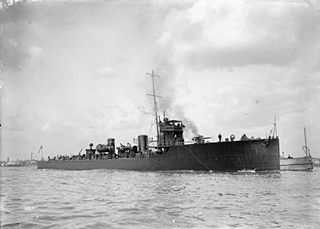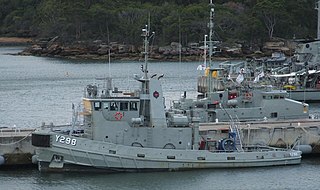
A corvette is a small warship. It is traditionally the smallest class of vessel considered to be a proper warship. The warship class above the corvette is that of the frigate, while the class below was historically that of the sloop-of-war.
The Brazilian Navy is the naval service branch of the Brazilian Armed Forces, responsible for conducting naval operations.

The Daphné-class submarine was a class of the diesel-electric powered submarines designed and constructed for the French Navy in 1964. Marketed by the French government for the export market, the Daphné design went on to serve in South Africa while there were subclasses based on the Daphné design that were commissioned in the navies of Pakistan, Portugal, and Spain. The submarines were in operation between 1964 and the late 1990s, their service lives being extended to fill the capability gap until the newer French nuclear submarines became available. Two French submarines were lost and a third was sunk, but was salvaged.

São Paulo was a dreadnought battleship of the Brazilian Navy. It was the second of two ships in the Minas Geraes class, and was named after the state and city of São Paulo.
HMS Berkeley was a Hunt-class mine countermeasures vessel of the British Royal Navy. She was sold to the Hellenic Navy in 2001 and was commissioned as HS Kallisto. On 27 October 2020, she was cut in two in a collision with a container ship.

The Inhaúma class are a series of five corvettes operated by the Brazilian Navy. These ships were built in Brazil and designed with assistance from the German company Marine Technik. It was originally planned to build 12 to 16 ships but the economic situation in Brazil did not permit this and only five vessels were built. The first two ships were constructed at the Arsenal de Marinha in Rio de Janeiro, the second pair by Verolme. The programme was considerably delayed due to funding issues and the Brazilian Verolme yard's insolvency in 1991 which forced Júlio de Noronha and Frontin to be completed by Arsenal da Marinha. The first ship entered service in 1989 and the last in 2008. Three of the five ships have been taken out of service and one was sunk in a missile exercise in the Atlantic Ocean in 2016.
HMCS Chaleur was a Bay-class minesweeper that served in the Royal Canadian Navy for three and a half months in 1954 before being sold to the French Navy to become La Dieppoise. The ship was named for Chaleur Bay, located between Quebec and New Brunswick. Her name was given to her replacement, Chaleur. As La Dieppoise, the vessel served as a coastal patrol vessel in the France's Pacific Ocean territories. The ship was taken out of service in 1987. In January 1988, the vessel was sunk as an artificial reef in the lagoon of Nouméa.

The Glen-class tug is a class of naval tugboat operated by the Royal Canadian Navy. Constructed in Canada, the class entered service between 1975 and 1977. The five vessels that comprise the class are split between the two major naval bases of the Royal Canadian Navy. The Royal Canadian Navy operated a fleet of tugboats during the Second World War which were also named the Glen class. The vessels of the current Glen class are each named after one of the vessels of the earlier class.

The João Coutinho-class corvettes were a series of warships built for the Portuguese Navy for service in Portugal's African and Indian colonies. Initially rated as frigates, they were downgraded first to corvettes and then patrol vessels with age. They were designed in Portugal by naval engineer Rogério de Oliveira, but the urgent need of their services in the Portuguese Colonial War meant that the construction of the ships was assigned to foreign shipyards. Six ships were built; the first three ships were built by Blohm & Voss and the remaining three by Empresa Nacional Bazán. The ships were launched in 1970 and 1971. The relative cheap cost of the design led to it being the basis of several other classes in other navies. From 1970 until the end of the conflict in 1975, the corvettes were used for patrol and fire-support missions in Angola, Mozambique, Guinea and Cape Verde. After the African colonies gained their independence, the corvettes were assigned to patrol duties in Portuguese territorial waters.

HMS Ariel was an Acheron-class destroyer built in 1911, which served during the First World War and sank in 1918 after striking a mine. Named after Shakespeare's "airy spirit", or the biblical spirit of the same name, she was the tenth and last ship of the name to serve in the Royal Navy.

Cv Caboclo (V19) is an Imperial Marinheiro-class corvette of the Brazilian Navy. Caboclo was the fifth of the Imperial Marinheiro-class corvettes ordered by the Brazilian Navy in 1953. Caboclo was launched on 19 August 1954, and commissioned on 16 July 1955.

Karoline Mariechen "Karol" Meyer is a Brazilian free diver. She holds two Guinness Book of World Record records: one for apnea free diving, with a dive of 121 m (328 ft), and one for static apnea with oxygen with a time of 18 minutes and 32 seconds.

Cv Barroso (V-34) is a corvette of the Brazilian Navy, and the lead ship of its sub class. The fifth Brazilian warship to be named after Admiral Francisco Manoel Barroso da Silva, Barroso was launched on 20 December 2002 and commissioned on 19 August 2008.

Two Minas Geraes-class battleships were built for the Brazilian Navy in the early twentieth century. Named Minas Geraes and São Paulo, these "dreadnought" warships were intended to be Brazil's first step towards becoming an international power, and they consequently initiated a South American naval arms race.

The Bandicoot class was a ship class of two minesweeper tugboats operated by the Royal Australian Navy (RAN). MSA Bandicoot and MSA Wallaroo were built in 1982 for Maritime (PTE) Ltd. as the tugboats Grenville VII and Grenville V. In 1990, the RAN purchased the vessels for conversion into auxiliary minesweepers under the Craft of Opportunity Program (COOP). The vessels could be equipped with a sidescan sonar and various towed minesweeping arrays, and also functioned as berthing tugs. Both vessels were placed in reserve in 2010, but were deployed on several occasions since to provide berthing support to nuclear-powered warships. They were removed from naval service in 2014.

NS Lt Gen Dimo Hamaambo (C11) was an Imperial Marinheiro-class corvette of the Namibian Navy. Originally built for the Brazilian Navy as Purus. Purus was part of ten ships of the class ordered by the Brazilian Navy in 1953. Purus was laid down on 20 November 1953, launched on 6 November 1954, and commissioned on 4 July 1955.

The Brazilian ironclad Colombo was a Cabral-class armored corvette-type ironclad operated by the Imperial Brazilian Navy between 1866 and 1875. The vessel was built in the shipyard in Greenwich, England, by the British company J. and G. Rennie, along with her sister ship Cabral. It was launched in 1865 being commissioned on 4 July 1866. The battleship was entirely made of iron, displacing 1,069 tons. It had two steam engines that developed up to 750 HP of power, propelling the vessel at about 20 km/h. Its structure comprised a double casemate with eight gunports. The Brazilian navy had great difficulties with this ship, which was hard to navigate and, due to the casemate's model, had an unprotected section, which was vulnerable to diving projectiles.

Laurindo Pitta is a museum ship and former tugboat of the Brazilian Navy, subordinated to the Directorate of Historical Heritage and Documentation of the Navy (DHHDN). She is the oldest boat of the navy still in service, being built by the British shipyard Vickers, Sons & Maxim, Ltd, in 1910. The tugboat is 39 meters long and displaced up to 514 tons in weight. She belonged to the Naval War Operations Division, part of the Brazilian squadron sent to patrol the northeastern African coast during World War I. In World War II, she participated in helping to defend the port of Rio de Janeiro. Laurindo Pitta was decommissioned on 16 September 1959, but was still used by the Brazilian Navy until the 1990s.

Imperial Marinheiro was a cruiser operated by the Imperial Brazilian Navy between 1884 and 1887. It was the second Brazilian ship to bear this name, a tribute to the country's sailors. It sank in 1887, near the mouth of the Doce River, in Espírito Santo.













